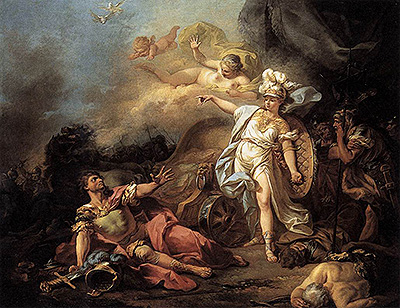Jacques Louis David is one of France foremost neoclassical painters. His style of painting is unique, basing on history and occurrences. During his time, the social and political revolutions were the order of the day, and his art tried to create a picture of such scenes.
The Minerva Fighting Mars painting is one among many in that line. Minerva is a Roman goddess of wisdom and art while Mars is a god of war. Their fighting is a clear sign of emotional relevance. The painting was done in 1771. It was an oil painting on canvas. It showed two waring deities, with human casualties. The impression of the two waring deities factors dominance over humanity, with the female deity (Minerva in this context), seems to dominate the male deity (Mars). This mythology painting opens up the conversations on supernatural force and their influence on human life.
It was influenced by a historical age in Greece when wars were considered a show of might and power. Originally it was meant to compete in the French Scholarship Promotion dubbed Prix de Rome. The winner was given a scholarship to go to Rome for a maximum of 5 years to study art. Although Jacques Louis David did not win with this Painting, it was the experience that propelled him to win in the 1774 edition. The painting is currently housed at the Louvre Museum which is one of the world’s epicentres of art, and France’s biggest art exhibition of all time. Most of David’s neoclassical paintings were based on history and political figures. This earned him a name in the French Revolution and a place at the high table in French and the Roman political world.
Born and bred around architects, his love for drawing was eminent from a young stage. He did his painting pupillage guided by François Boucher and Joseph-Marie Vien. He thereafter had a stint at Academie Royale de Peinture et de Sculpture. Some of his famous works around the 1770s include the Diane et Appollon percant de leurs fleches les enfants de Niobe (1772), Death of Seneca (1773) and the Antiochus and Stratonice (1774). He was also a master of portraits, with some of the notable figures in the French authority as his customers. David had a great following, shepherding a good number of French and Roman painters. Among his pupils were Antoine-Jean Gros, Jean Auguste Ingres and Jean-Martin Langlois. His name is big in France and beyond, and is considered the best French artist who ever lived.




